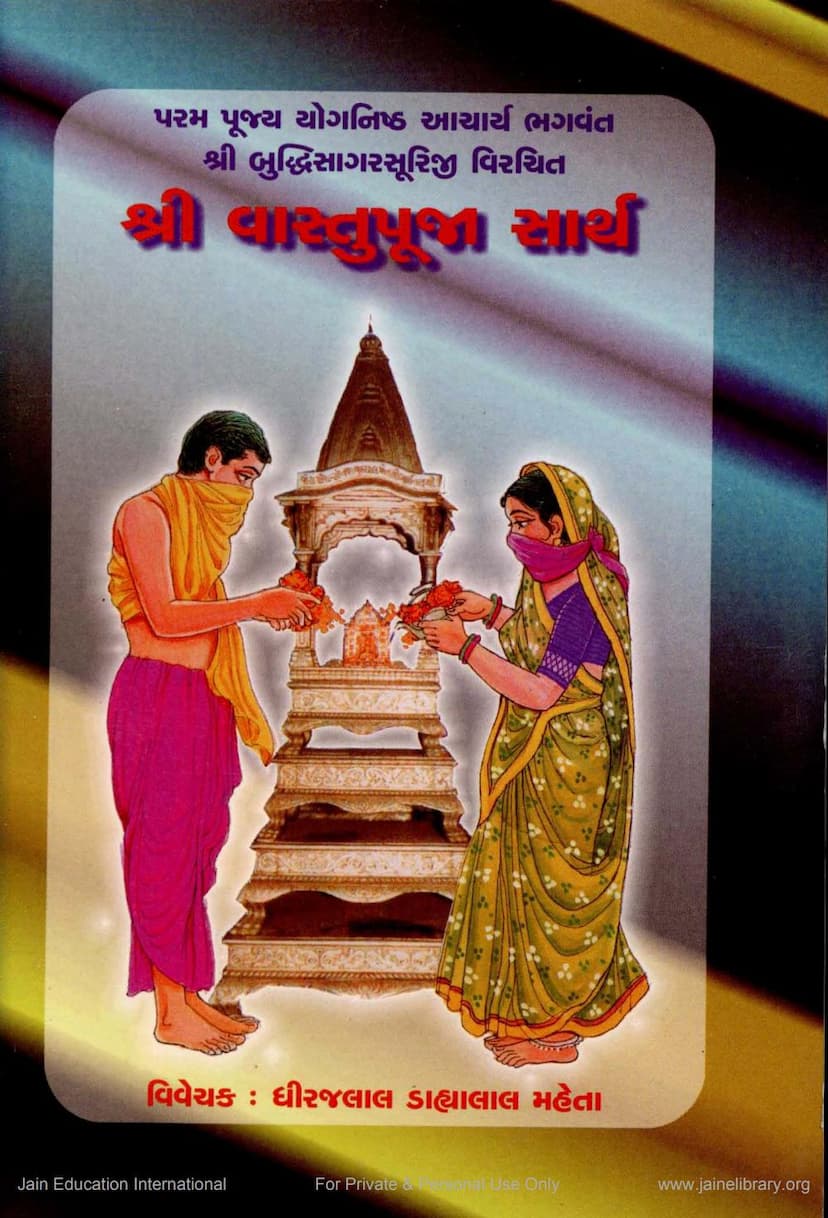Vastupooja Sarth
Added to library: September 2, 2025

Summary
This document is the "Vastupooja Sarth" (meaning "Vastupooja with Meaning"), a Jain text authored by Param Pujya Yognishth Acharya Bhagwant Shri Buddhisagarsuriji and critically reviewed by Dhirajlal Dahyalaal Mehta. It is published by Shri Jain Dharm Prasaran Trust, Surat.
The book is essentially a guide to performing "Vastupooja," a ritual performed during the housewarming ceremony of a new building (Vastu), with detailed explanations and meanings in Gujarati. The core of the text is the "Vastupooja Vidhi" (Ritual of Vastupooja) attributed to Acharya Buddhisagarsuriji.
Here's a breakdown of the key content:
-
Author and Publisher: The work is by Acharya Buddhisagarsuriji, a significant Jain monk, and the commentary is by Dhirajlal Dahyalaal Mehta. The publishing house is dedicated to the propagation of Jain Dharma.
-
Inspiration and Purpose: The text aims to provide a deeper spiritual understanding of the Vastupooja ritual. The author believes that by understanding the profound meanings behind the prayers, individuals can gain insight into their own spiritual "home" (Atma-ghar). The book is intended for private and personal use.
-
Biographical Information: A significant portion of the initial pages (pages 6-11) is dedicated to the concise biography of Acharya Buddhisagarsuriji. It details his birth, upbringing, his profound encounter with Jainism that led him to renounce worldly life and embrace monasticism. It highlights his prolific writing career, establishing the "Adhyatma Gyan Prasarak Mandal," his intellectual debates with prominent figures of his time, his role in the establishment of the temple of Shri Ghantakarna Mahavir, and his eventual attainment of liberation (moksha).
-
The Ritual of Vastupooja:
- General Instructions: The text outlines the general procedure for Vastupooja, emphasizing the use of five of each item for the eight types of offerings (Ashtaprakari Pooja). It mentions the importance of bathing the deity (Snatra) and performing the worship with devotion.
- The Five Pujas (Five Stages of Worship): The core of the "Vastupooja Vidhi" is presented in five stages or "Pujas." Each puja includes Doha (couplets) and Dhal (songs/verses), followed by their Gujarati explanations.
- First Puja: This puja is dedicated to Lord Shankeshwar Parshvanath, invoking his grace and blessings. It describes his divine presence and the worship offered by Dharanendra and Padmavati.
- Second Puja: This continues the devotion to Lord Parshvanath, emphasizing the importance of singing his praises and remembering his name. It also introduces the concept of material offerings.
- Third Puja: This section differentiates between "Shubh Vastuk Puja" (auspicious Vastupooja) and "Ashubh Vastuk Puja" (inauspicious Vastupooja). It strongly condemns the latter, which involves rituals of other faiths, animal sacrifice, and idol worship of non-Jain deities, associating them with negative karmic consequences and rebirth in hell. It then elaborates on the "Shubh Vastuk Puja," which involves devotion to the Tirthankaras, charity to worthy recipients, and listening to scriptures.
- Fourth Puja: This puja delves into deeper philosophical aspects, emphasizing the ephemeral nature of the physical body and the cyclical journey of the soul through various life forms. It reiterates the importance of devotion to Lord Parshvanath as a means to overcome worldly suffering and attain liberation.
- Fifth Puja: This puja focuses on "Bhava Vastuk Puja" (worship through internal spiritual feelings). It explains that the true "home" of the soul is its own pure, conscious nature. It describes the attributes of the soul (Atma) as distinct from material substances (Pudgal), eternal, omniscient, and blissful. It also touches upon the complex doctrines of anekantavada (non-absolutism) and the nature of reality.
-
Spiritual Interpretation: Throughout the explanation of the pujas, the text consistently draws parallels between the outward rituals and the inward spiritual journey. The offerings and prayers are interpreted as symbolic representations of the soul's quest for purity, knowledge, and liberation. The ultimate goal is described as achieving the "Atma-ghar" – the true dwelling place of the soul in its liberated state.
-
Mantra: A specific mantra, "Om Namo Bhagavate Shri Shankeshwar Parshvanathaya," is provided and explained, invoking Lord Parshvanath and his divine attendants Dharanendra and Padmavati for protection from birth, old age, death, and other adversities, through the eight types of offerings.
-
Significance of the Author's Name: The text subtly incorporates the author's name, "Buddhisagar," within the verses, particularly when discussing wisdom and ultimate liberation.
-
Commendation and Blessing: The book concludes with verses that bless the readers with peace, contentment, prosperity, and the ultimate attainment of liberation, emphasizing the efficacy of the "Vastupooja" when performed with devotion and understanding.
In essence, "Vastupooja Sarth" is a devotional and philosophical text that guides Jain followers on how to perform the Vastupooja with both outward rituals and inward spiritual contemplation, connecting the earthly act of building a new home to the ultimate goal of realizing the soul's true, eternal abode. It also serves as a tribute to the life and teachings of Acharya Buddhisagarsuriji.